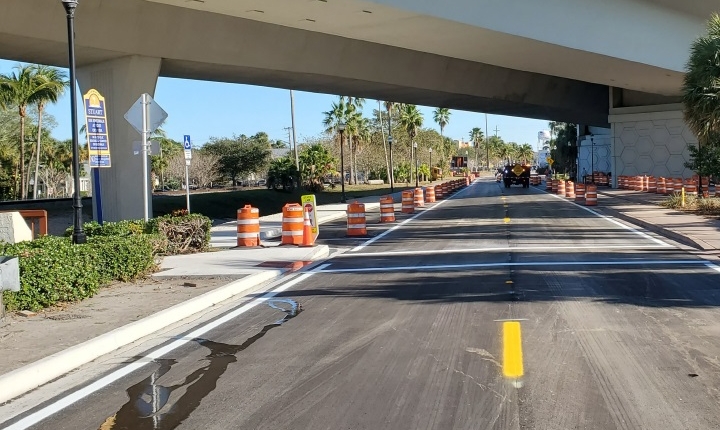Roosevelt Bridge Emergency Repair Project – Stuart, Florida
The Roosevelt Bridges are twin precast segmental structures, each being approximately 60 ft. wide and 4500 ft. long, that carry northbound (NB) and southbound (SB) US Route 1 (SR-5) over the St. Lucie River in Stuart, FL. US-1 is a major north-south artery that connects the City of Stuart with Jensen Beach and the City Port St. Lucie and has an Average Annual Daily Traffic (AADT) of approximately 60,000 vehicles per day.
On June 16, 2020, during a routine biennial inspection and based on feedback from local partners, inspectors found cracks in Span 1 of the SB Bridge which necessitated its closure as well as the roadway traversing underneath the bridge (Dixie Highway). Out of an abundance of caution, the NB Bridge was also closed until a thorough inspection of the structure could be performed. Inspections of both bridges determined that SB bridge had sustained significant structural damage in Span 1 and would need to remain closed for an extended duration however, the NB Bridge was deemed safe to re-open with a few minor enhancements.
The inconvenience posed by the SB bridge closure, weight restrictions, detours and overall capacity conveyance reduction on US-1 was significant and had far reaching impacts within the local community. This necessitated that “time was of the essence” to complete the repairs needed to re-open the SB Bridge, lift the weight restrictions, and remove the detours. Thus, the Department decided to utilize the Construction Manager/General Contractor (CM/GC) contract delivery method in order to accomplish the repairs expediently.
Innovation of Design and/or Construction
The Roosevelt Bridge restoration could not have been successful without innovative solutions. Integration of multi-discipline inspection results with structural analysis, innovative procurement processes and pioneering contracting procedures all played an important role. The most dramatic concept was the cutting free and temporary support of the southernmost 70’ of bridge weighing 600 tons. The staged cutting was accomplished with a combination of a wire rope saw and demolition hammers to allow critical utilities in the barriers to remain undamaged in the process. The remaining tendons were then slackened by cutting at the segment joints. This procedure required the continual adjustment of temporary supporting jacks and surveying.
Rapid Construction
Scheduling challenges were addressed by an aggressive partnering effort and innovative procurement process. A core team of consultants, FDOT, local government and industry representatives, technical experts, and legal experts met daily to build a (first of its kind for FDOT) CM/GC team which achieved an extremely fast paced and successful project. Procurement was accelerated with an award to Structural Technologies after a 3-week procurement process. Once the contract manager was on-board, bridge and roadway design plans were completed in 24 days. Construction began immediately and within 130 days the final traffic configuration was restored on US-1. During these 130 days, preservation plans were developed and the repairs implemented.
Aesthetics and/or Harmony with the Environment
Scheduling challenges were addressed by an aggressive partnering effort and innovative procurement process. A core team of consultants, FDOT, local government and industry representatives, technical experts, and legal experts met daily to build a (first of its kind for FDOT) CM/GC team which achieved an extremely fast paced and successful project. Procurement was accelerated with an award to Structural Technologies after a 3-week procurement process. Once the contract manager was on-board, bridge and roadway design plans were completed in 24 days. Construction began immediately and within 130 days the final traffic configuration was restored on US-1. During these 130 days, preservation plans were developed and the repairs implemented.
Cost Competitiveness
Reduced capacity and resulting traffic limitation on the Roosevelt Bridge had the potential for considerable cost impacts to the surrounding community. Given this, time literally was money and thus, for the first time in FDOT’s history, the CM/GC contract delivery method utilizing open book cost estimating was chosen to ensure fair and equitable pricing for the project. This delivery method allowed for continued repair scope refinement throughout the construction phase which ensured that only the critical repairs needed to expeditiously open the road to the full six-lanes of traffic were completed as part of the emergency contract.
Minimization of Construction Impact on the Traveling Public
The project began with the sudden and unplanned loss of a major bridge link restoring traffic became a top priority. More specifically, restoring traffic to the greatest extent possible as early as possible. This was realized through a series of monetary milestone capacity restorations targeting high demand days. First, repairs allowed for partial re-opening on SB bridge to open (2 lanes) within 3 months. Secondly, full capacity (3 lanes on each of the two bridges) was restored prior to the Christmas holiday and the Stuart Boat Show. There were also no impacts to marine or railroad traffic, beyond the initial temporary bridge closure. This required work at night and off-peak to avoid impacts and meet these goals.
Jury Comments
CM/GC process allowed for the state to partner together to complete the rehabilitation in a short schedule. Assembling the right team with the right experience ensured success. Bringing the state, contractor, designer, and specialists allowed the complex bridge work to be done safely and efficiently. Getting contractor involvement was key.
2021 ASBI Bridge Award of Excellence
Category: Special Projects
State:
Florida
Owner:
Florida DOT – District 4
Owner’s Engineers:
HDR
Designer:
Corven Engineering Inc. / Hardesty & Hanover
Contractor:
Structural Technologies
Construction Engineering Services:
Janssen & Spaans Engineering
Construction Engineering Inspection:
Cardno
Precast Producer:
Johnson Bros. Corporation
Formwork for Precast Segments:
Structural Technologies (VSL)
Post-Tensioning:
Structural Technologies (VSL)






